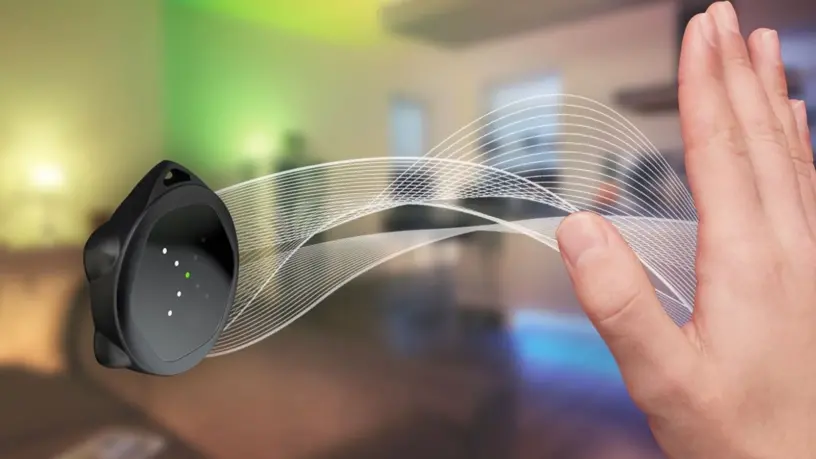Introduction
The Gesture Recognition Market involves the development and adoption of technologies that interpret human gestures as input commands for various devices. These technologies use sensors, cameras, and advanced algorithms to recognize and interpret gestures such as hand movements, facial expressions, and body motions. Gesture recognition is increasingly being integrated into a variety of applications, including consumer electronics, automotive systems, healthcare, gaming, and industrial automation, enhancing user interaction and experience.
Market Trends
- Integration with Consumer Electronics: Gesture recognition technology is being widely adopted in consumer electronics such as smartphones, tablets, and smart TVs, providing touchless interaction and improving user experience.
- Automotive Sector Growth: The automotive industry is increasingly incorporating gesture recognition systems to enhance driver safety and comfort, enabling hands-free control of in-car systems like infotainment, navigation, and climate control.
- Advancements in AI and Machine Learning: The development of more sophisticated AI and machine learning algorithms is improving the accuracy and reliability of gesture recognition systems, expanding their applicability.
- Healthcare Applications: Gesture recognition is gaining traction in healthcare, where it is used for patient monitoring, remote surgeries, and physical therapy, offering non-invasive and efficient control methods.
Market Dynamics
- Technological Innovation: Continuous advancements in sensor technology, AI, and machine learning are driving the development of more precise and responsive gesture recognition systems.
- User Experience Demand: The growing demand for intuitive and seamless user interfaces in electronic devices is a major factor driving the adoption of gesture recognition technology.
- Cost Considerations: While gesture recognition offers advanced interaction capabilities, the high cost of implementation, especially in consumer electronics, can be a barrier to widespread adoption.
- Regulatory Environment: The use of gesture recognition in certain sectors, particularly in automotive and healthcare, is subject to stringent regulatory standards, influencing market dynamics.
Key Drivers
- Increasing Adoption in Automotive: The push for enhanced driver safety and the trend towards autonomous vehicles are driving the adoption of gesture recognition technology in the automotive industry.
- Demand for Touchless Interfaces: The growing need for touchless interfaces, especially in the context of health concerns such as pandemics, is boosting the demand for gesture recognition solutions.
- Consumer Electronics Evolution: The ongoing evolution of consumer electronics, with a focus on enhanced user interaction, is a significant driver of gesture recognition market growth.
- Rise of AR and VR: The increasing use of augmented reality (AR) and virtual reality (VR) technologies in gaming and training applications is propelling the demand for advanced gesture recognition systems.
Benefits
- Enhanced User Interaction: Gesture recognition technology provides a more natural and intuitive way for users to interact with devices, improving the overall user experience.
- Hands-Free Control: By enabling hands-free control, gesture recognition enhances convenience and safety, particularly in applications like automotive and healthcare.
- Accessibility: Gesture recognition systems can improve accessibility for users with disabilities, allowing them to interact with devices through gestures rather than traditional input methods.
- Innovative Applications: The technology opens up new possibilities for innovative applications across various industries, from gaming to industrial automation.
Challenges and Threats
- High Implementation Costs: The cost of developing and integrating gesture recognition technology into devices can be high, which may limit its adoption in price-sensitive markets.
- Accuracy and Reliability: Ensuring high accuracy and reliability of gesture recognition systems across different environments and user conditions remains a technical challenge.
- Privacy Concerns: The use of cameras and sensors to track and analyze gestures raises privacy concerns, particularly in public and personal spaces.
- Competition from Alternative Interfaces: Gesture recognition faces competition from other advanced input methods, such as voice recognition and touch interfaces, which could limit its market penetration.
Future Outlook
The Gesture Recognition Market is poised for significant growth as technology continues to advance and user demand for more intuitive and seamless interfaces increases. The automotive sector is expected to be a major driver, with the integration of gesture recognition systems in vehicles becoming more widespread. Additionally, the rise of AR, VR, and smart home technologies will create new opportunities for gesture recognition applications. Despite challenges such as high costs and privacy concerns, the market is likely to expand as the technology becomes more accessible and refined.
𝐂𝐥𝐢𝐜𝐤 𝐇𝐞𝐫𝐞, 𝐓𝐨 𝐆𝐞𝐭 𝐅𝐫𝐞𝐞 𝐒𝐚𝐦𝐩𝐥𝐞 𝐑𝐞𝐩𝐨𝐫𝐭
https://stringentdatalytics.com/sample-request/gesture-recognition-market/14127/
Market Segmentations:
Global Gesture Recognition Market:
#ByCompany
ArcSoft
Crunchfish
eyeSight Technologies
Intel
Microsoft
PointGrab
Samsung
SoftKinetic
Sony
Global Gesture Recognition Market:
#ByType
2D Gesture Recognition
3D Gesture Recognition
Global Gesture Recognition Market: By
#Application
Automotive
Consumer Electronics
Healthcare
Others
Global Gesture Recognition Market: Regional Analysis
The regional analysis of the global Gesture Recognition market provides insights into the market’s performance across different regions of the world. The analysis is based on recent and future trends and includes market forecast for the prediction period. The countries covered in the regional analysis of the Gesture Recognition market report are as follows:
North America: The North America region includes the U.S., Canada, and Mexico. The U.S. is the largest market for Gesture Recognition in this region, followed by Canada and Mexico. The market growth in this region is primarily driven by the presence of key market players and the increasing demand for the product.
Europe: The Europe region includes Germany, France, U.K., Russia, Italy, Spain, Turkey, Netherlands, Switzerland, Belgium, and Rest of Europe. Germany is the largest market for Gesture Recognition in this region, followed by the U.K. and France. The market growth in this region is driven by the increasing demand for the product in the automotive and aerospace sectors.
Asia-Pacific: The Asia-Pacific region includes Singapore, Malaysia, Australia, Thailand, Indonesia, Philippines, China, Japan, India, South Korea, and Rest of Asia-Pacific. China is the largest market for Gesture Recognition in this region, followed by Japan and India. The market growth in this region is driven by the increasing adoption of the product in various end-use industries, such as automotive, aerospace, and construction.
Middle East and Africa: The Middle East and Africa region includes Saudi Arabia, U.A.E, South Africa, Egypt, Israel, and Rest of Middle East and Africa. The market growth in this region is driven by the increasing demand for the product in the aerospace and defense sectors.
South America: The South America region includes Argentina, Brazil, and Rest of South America. Brazil is the largest market for Gesture Recognition in this region, followed by Argentina. The market growth in this region is primarily driven by the increasing demand for the product in the automotive sector.
Click Here, To Buy Premium Report
https://stringentdatalytics.com/purchase/gesture-recognition-market/14127/?license=single
Key Questions Answered in This Report:
1. What are the primary technologies used in gesture recognition systems (e.g., computer vision, infrared sensors, electromagnetic sensors)?
2. How is gesture recognition being integrated into consumer electronics and everyday devices?
3. What are the key challenges associated with the accuracy and reliability of gesture recognition systems?
4. How do advancements in artificial intelligence and machine learning impact the development of gesture recognition technologies?
5. What are the major applications of gesture recognition in sectors such as healthcare, automotive, and gaming?
6. How do different geographic regions vary in terms of adoption and growth of gesture recognition technology?
7. What are the leading companies and innovators in the gesture recognition market, and what are their key offerings?
8. What role do privacy and data security concerns play in the deployment of gesture recognition systems?
9. How is the market for gesture recognition expected to evolve with the growth of augmented reality (AR) and virtual reality (VR)?
10. What are the typical cost structures and pricing models for gesture recognition solutions, and how do they vary across different applications?
About Stringent Datalytics
Stringent Datalytics offers both custom and syndicated market research reports. Custom market research reports are tailored to a specific client’s needs and requirements. These reports provide unique insights into a particular industry or market segment and can help businesses make informed decisions about their strategies and operations.
Syndicated market research reports, on the other hand, are pre-existing reports that are available for purchase by multiple clients. These reports are often produced on a regular basis, such as annually or quarterly, and cover a broad range of industries and market segments. Syndicated reports provide clients with insights into industry trends, market sizes, and competitive landscapes. By offering both custom and syndicated reports, Stringent Datalytics can provide clients with a range of market research solutions that can be customized to their specific needs.
Contact Us
Stringent Datalytics
Contact No- +1 346 666 6655
Email Id- sales@stringentdatalytics.com
Web- https://stringentdatalytics.com/




Leave a Reply